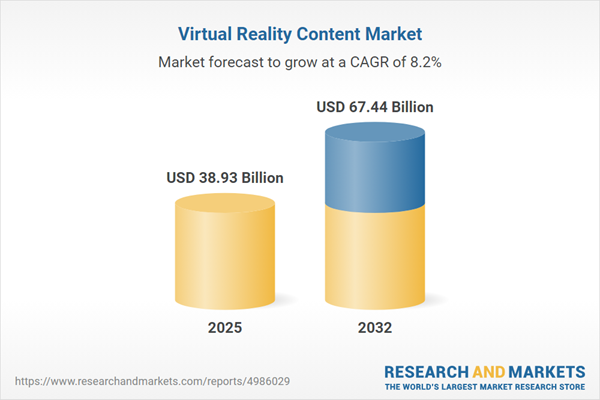Speak directly to the analyst to clarify any post sales queries you may have.
Virtual reality content is reshaping B2B enterprise strategies by enabling immersive experiences that drive innovation, elevate workforce skills, and foster sharper engagement with employees and clients. This market analysis presents actionable insights for senior decision-makers aiming to leverage virtual reality content for sustained operational and competitive success.
Market Snapshot: Virtual Reality Content Market
In 2024, the global virtual reality content market achieved a valuation of USD 35.99 billion, with projections indicating growth to USD 38.93 billion in 2025 and USD 67.44 billion by 2032. The sector is advancing at a compound annual growth rate (CAGR) of 8.16%, signifying growing momentum for enterprise integration.
This expansion is being propelled by sustained investments in immersive training, increasing demand for interactive applications, and a broader deployment of VR solutions across verticals. Enterprises prioritize solutions that facilitate secure data management, resilient real-time analytics, and seamless compatibility with established business platforms, thus generating strategic value for varied sectors.Scope & Segmentation of the Virtual Reality Content Market
Comprehending the scope and segmentation of the virtual reality content market is vital for optimizing procurement and operational planning. Key segments underscore driver adoption areas and outline opportunities for technology-driven differentiation in both established and emerging markets.
- Content Type: Includes enterprise-focused training and simulation modules, immersive entertainment mediums, healthcare rehabilitation programs, industrial design visualization, and interactive property experiences, supporting goals from upskilling to operational efficiency enhancement.
- Device Type: Encompasses mixed reality headsets, mobile-enabled VR devices, gaming consoles, and PC-tethered systems, all influencing user adoption rates, integration adaptability, and alignment with organizational IT infrastructures.
- Revenue Model: Consists of in-app purchase structures, digital advertising integration, enterprise/OEM licensing agreements, and subscription models, each streamlining procurement for organizations with different operational needs.
- Distribution Platform: Incorporates principal channels such as Oculus, PlayStation, Steam, WebVR browsers, direct B2B distribution pathways, and value-added resellers, adapting to diverse compliance protocols and enterprise IT requirements.
- End User: Serves both consumer sectors—such as gaming, fitness, and social engagement—as well as enterprise environments including education, healthcare, advanced manufacturing, and property management, where process improvement and competitive differentiation are priorities.
- Geographic Coverage: Reflects regional adoption trends and regulatory environments across the Americas, Europe, Middle East & Africa, and Asia-Pacific, in response to digital infrastructure advancement and local market dynamics.
- Major Companies: Features solution providers like Novac Technology Solutions, Samsung Electronics, Juniper Networks, Microsoft, Google, Fusion VR, The VR Company, AutoVRse, Simulanis Solutions, and Q3 Technologies, driving enterprise digital transformation on a global scale.
Key Takeaways for Enterprise Decision-Makers
- Immersive content platforms are redefining digital learning approaches, supporting talent development and employee engagement within interactive VR environments.
- Scalable and customizable content solutions ensure straightforward integration with existing systems, strengthening analytic capacity and supporting long-term operational goals.
- Flexible procurement models, including subscriptions and licensing, allow organizations to evaluate VR capabilities with low barriers to entry and minimal business disruption.
- Well-configured VR deployments support compliance with local and sector-specific regulations, enhancing operational efficiency while prioritizing robust data security.
- Supplier diversification and proactive supply chain management reinforce resilience, guarding against fluctuations in equipment supply or dynamic market conditions.
- Standardized evaluation and deployment strategies increase the likelihood of successful VR content adoption across enterprise environments, accelerating return on investment.
Tariff Impact
Recent tariff adjustments have influenced hardware procurement costs in the virtual reality content sector. Enterprises are mitigating these impacts by fortifying supply chain resilience, diversifying their supplier portfolios, exploring nearshoring possibilities, and refining inventory management practices. These steps help sustain consistent device availability and uphold business agility amid shifting international conditions.
Methodology & Data Sources
This report synthesizes input from executive interviews, industry expert commentary, and comprehensive quantitative market analysis. Supporting resources, including case studies and policy assessments, reinforce the relevance and applicability of guidance tailored to enterprise strategic objectives.
Why This Report Matters
- Supplies procurement leads and product strategists with actionable intelligence to refine operations and secure advantages in virtual reality content integration.
- Enables decision-makers to manage regulatory complexity and adapt to evolving business conditions and sector-specific requirements across global regions.
- Promotes the development of robust go-to-market tactics and technology partnerships, supporting broad-based and effective enterprise VR deployment.
Conclusion
Strategic adoption of virtual reality content requires coordinated planning and organizational adaptability. Enterprises embedding these principles are best positioned to realize operational gains and capitalize on the ongoing evolution of immersive technology.
Additional Product Information:
- Purchase of this report includes 1 year online access with quarterly updates.
- This report can be updated on request. Please contact our Customer Experience team using the Ask a Question widget on our website.
Table of Contents
3. Executive Summary
4. Market Overview
7. Cumulative Impact of Artificial Intelligence 2025
Companies Mentioned
The companies profiled in this Virtual Reality Content market report include:- Novac Technology Solutions
- Samsung Electronics Co., Ltd.
- Juniper Networks Inc
- Microsoft Corporation
- Google LLC
- Fusion VR
- The VR Company
- AutoVRse
- Simulanis Solutions Private Limited
- Q3 technologies, Inc.
Table Information
| Report Attribute | Details |
|---|---|
| No. of Pages | 197 |
| Published | October 2025 |
| Forecast Period | 2025 - 2032 |
| Estimated Market Value ( USD | $ 38.93 Billion |
| Forecasted Market Value ( USD | $ 67.44 Billion |
| Compound Annual Growth Rate | 8.1% |
| Regions Covered | Global |
| No. of Companies Mentioned | 11 |









